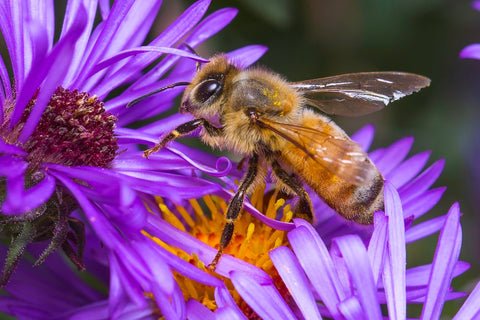Wasps and bees are often confused ... wrongly! We give you some little tips to get to know them better and to be able to differentiate them.
Their roles
You are no longer reminded of the importance of the bee in terms of pollination.
Indeed, by transporting pollen from the male reproductive organs to the female reproductive organs of flowers, it helps to preserve plant species on our planet.
Wasps also participate in pollination. They feed on small insects such as spiders, so they are very useful for the balance of ecosystems. They are therefore not used for "nothing" as one can hear it. For this reason, you should not destroy the nests systematically and always ask yourself if it is really justified.
The physical differences
The bee measures between 1.1 and 1.3 cm. She is hairy and stocky. It is covered with black bands. Between the bands, the color is brown to golden.

Bee
Like the bee, the wasp belongs to the Hymenoptera family. The wasp is slightly larger than the bee: it can measure between 1.1 and 1.8 cm. Its body is less hairy than the bee, Its dominant color is bright yellow with very marked black bands. His abdomen is separated from his thorax which gives him "an hourglass figure".
Just like bees, there are many species of wasps.

Wasp
The dietary differences
During meals taken outdoors, it is rare to be disturbed by bees. Because these feed exclusively on nectar and pollen. Our food does not interest them. Unless you leave an open jar of honey lying around ;)
On the other hand, wasps are omnivorous and are therefore interested in your plate, whether it is sweet or savory. Wasp larvae are even carnivorous. Wasps have a jaw that they use to devour their prey. This is why wasps can bother you during summer meals.
Differences in stings
These little beasts will never sting you for fun.
The bee is not aggressive, it will sting you if you get too close to the hive or if it feels in danger.
When it stings, it loses its sting and its abdomen, which will result in its death.
The bee sting is more allergenic and painful than the wasp sting.
There are stingless bees. These are the drones. They do not produce nectar, do not collect pollen, and do not have a stinger. Their only function is to be the male of the bee and comes down to reproduction. Their task accomplished, they generally do not survive long.
While impressive, don't be scared if you notice a swarm. Bees are not aggressive at this time because their stomachs are full of honey. Do not try to kill them with insecticide! Call a beekeeper as quickly as possible who will come and capture it to place it in a beehive. With the massive losses of colonies, he will no doubt be happy to be able to increase his herd.

Swarm of bees
Wasps are not basic aggressive. They will become so, just like the bee if they feel a danger (eg: sudden gestures). They can sting several times because they do not lose their sting.

Wasp's nest
In the wasp, only females have a stinger. So they are the ones who sting. Indeed, the stinger also has a reproductive function. Through the stinger, the fertile wasps deposit the eggs of the future larvae and it is this same conduit which is used to them to inject the venom to their prey.
There you are, now you may know a little more to recognize these two insects, very similar in appearance and yet very different in their functioning.







